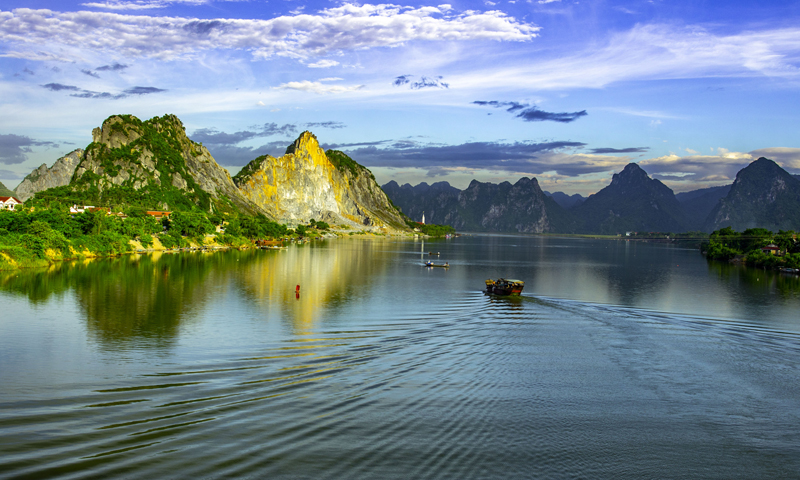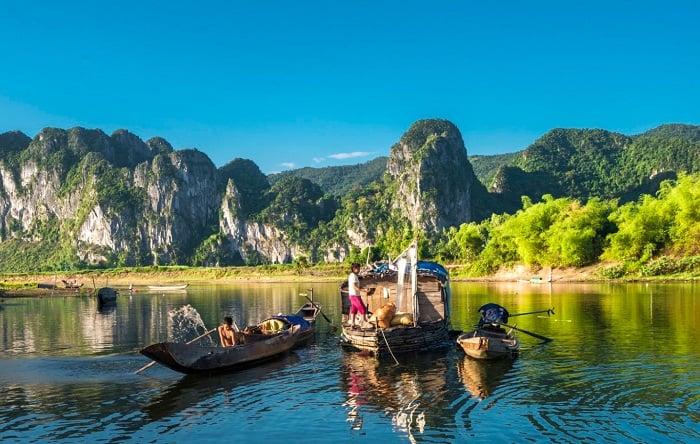The legendary Gianh River in Quang Binh
The Gianh River, with its wild and majestic beauty, has long been a symbol of Quang Binh. The Gianh River is a river flowing in Quang Binh Province, originating from the area along the 2,017 m high Co Pi mountain in the Truong Son range, flowing through the districts of Minh Hoa, Tuyen Hoa, Bo Trach, Quang Trach and Ba Don Town to flow into the East Sea at Gianh Gateway.

The majestic beauty of nature
The Gianh River is not only a river, but also a work of art of nature. The majestic rapids, the clear blue water, the primeval forests on both banks create a beautiful picture. When sailing on the Gianh River, visitors will be immersed in the peaceful space, listening to the birds chirping, the wind blowing, and feeling the majesty of nature.

Legends and history
The Gianh River is not only beautiful in nature but also contains many legends and historical stories. Quang Binh people have long considered Gianh River as a sacred river, closely associated with their lives.
Historically, Gianh River was called Linh Giang by its Chinese name. If Ngang Pass was the boundary between Dai Co Viet and Champa after the Vietnamese gained independence from 939 to 1069, Gianh River was the boundary during the Trinh - Nguyen period of the conflict between Dang Trong and Dang Ngoai (1570-1786) with nearly half a century of armed conflict (1627-1672).
During the Trinh - Nguyen war, Trinh troops were stationed at Ngang Pass, but the actual boundary dividing North - South Vietnam was Gianh River from 1627 to 1774. On the north bank of the river was Ba Don market, where Trinh troops bought food and exchanged goods.
In July 1885, King Ham Nghi, who was deposed by the French for his lack of cooperation and who called on the people to revolt, took refuge in the upper reaches of the river, a wild area of mountains and dense forests. It was there, in the small village of Ò Vé, that he was arrested on November 2, 1888 and exiled to Algiers, where he died in 1943.
Born in the midst of the brutal cycle of war, in addition to the suffering they had to endure, the people on both banks of the Gianh River forged an iron will and intelligence to defeat the plots to annex our country from foreign invaders in the past.
Cultural value
The Gianh River is not only a river, but also a precious cultural heritage. On both banks of the Gianh River, there are many traditional craft villages, ancient craft villages with unique architecture. The people here still preserve traditional cultural features, creating a colorful picture of life along the Gianh River.
The Gianh River now connects the two banks by a permanent bridge made of reinforced concrete. The Gianh River Victory Monument, Gianh Port, Gianh Bridge...
Tourism value
Today, the Gianh River is not only a river with historical and cultural significance but also an attractive tourist destination. Visitors can participate in activities such as: cruising on the river, exploring craft villages along the river, exploring historical relics associated with the Gianh River,...

This river provides irrigation water for the fields. At the same time, the Gianh River is also an important traffic route, connecting regions.
The Gianh River is a symbol of Quang Binh, an indispensable part of the souls of the people here. With its majestic natural beauty and profound cultural values, the Gianh River deserves to be an attractive destination for domestic and foreign tourists.
